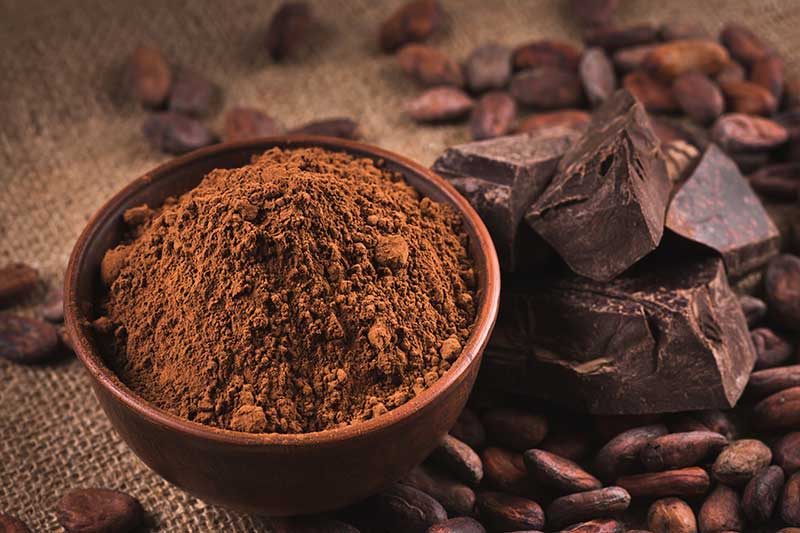Chocolate in all its rich goodness is something many of us can’t live without – from a sweet chocolate treat with a cup of coffee to a decadent dessert; we simply love chocolate. However, do you know that the chocolate you buy from your local shop has very little real or raw chocolate content? Sadly, most shop-bought chocolate is just milk, sugar and, of course, empty calories. But there’s a solution!
While chocolate with minimal raw chocolate tastes fine, real chocolate is a much better alternative and is even considered a ‘super food’ thanks to its numerous physical and mental health benefits.
Below, we look at the difference between cocoa and cacao and the benefits of raw chocolate.
What is Raw Chocolate?
The primary difference between your average shop-bought chocolate and raw chocolate is that producers heat the cacao beans used to make raw chocolate at no higher than 42-degrees, which retains the structure and integrity of the bean. However, to create the cocoa powder, cacao beans must be heated between 130 and 400-degrees. Just like when brewing coffee with boiling water, heating cacao beans at high temperatures destroys many of the enzymes and nutrients in the raw bean which means when you eat cocoa rather than cacao, you receive little to no nutritional value.
The other main difference between raw chocolate and commercial chocolate is the number of ingredients used to create the chocolate. For instance, a typical big-brand chocolate bar will include milk, soy, fat, sugar, sweeteners and, often, a roster of artificial flavours and preservatives. However, raw chocolate typically only has cacao powder, cacao butter, coconut palm sugar and, often, dried fruits or seeds which double as natural sweeteners while adding a kick of creativity and unique flavour.
As all the ingredients in raw chocolate are unprocessed, they have much higher nutritional value.
The Difference Between Cocoa and Cacao
While in language-terms cocoa and cacao are the same thing, most refer to cacao as cocoa when it has been processed, while cacao is cacao beans in their raw state or in reference to the tree on which they grow. When making cocoa powder, cacao is dutched; this involves washing the cacao paste in potassium carbonate to remove bitterness. During dutching, cacao loses up to 90% of its nutrients.
When making raw chocolate, usually, the cacao paste is not dutched which means all the nutrients, including those all-important antioxidants, enzymes, and other nutrients, remain intact, which makes raw chocolate much more nutritionally beneficial than processed chocolate from big-name brands.
Health Benefits of Raw Chocolate
Studies show that dark chocolate, which contains high-levels of raw cacao, has a host of health benefits. The darker the chocolate, the higher the cacao content. Ideally, you should strive to eat chocolate that is at least 65% cacao to benefit the most. Similarly, darker chocolate also has more anti-oxidants and enzymes and avoids unhealthy ingredients such as high-fat milk and processed sugar.
The Ecologist’s Hannah Corr describes cacao as “a powerhouse of over 300 nutrients including antioxidants, flavonoids, fiber, iron, zinc, copper, calcium and magnesium.” She adds, “It also contains tryptophan, known to ameliorate depression, and the bliss inducing chemicals anandamide and phenylethylamine which simulate the feeling of falling in love. Oh, and it’s an aphrodisiac.”
Cacao contains more antioxidants per 100g than acai berries, goji berries, and blueberries. Raw chocolate also contains significant amounts of essential vitamins and minerals such as magnesium, calcium, zinc, iron, potassium, and those all-important E and B vitamins. Rather than chowing down on chocolate packed with saturated fat, raw chocolate has healthy levels of monounsaturated fat; also known as ‘good fat’. Raw chocolate also has high-levels of protein and fiber and can even help to boost the release of endorphins which, as Corr says, will help to improve your mood and make you happy.
According to Kristin Kirkpatrick, dietitian and Manager of Wellness Nutrition at Cleveland Clinic’s Wellness Institute, dark chocolate also reduces stress. Kristin says, “A 2009 study found that having a small amount of dark chocolate helped to ease subjective stress in study participants.” Adding, “This is significant because only a small amount was needed to gain results and it was a food we know is high in healthy flavanols, as opposed to normal stress foods like mac and cheese, candy and alcohol.”
Other physical and mental benefits of raw chocolate include improved memory, lower chances of developing heart disease or stroke, lower blood pressure, better vision, and improved immunity.
Where to Buy Raw Chocolate
Getting hold of raw or real chocolate isn’t as difficult as you might think. With healthy eating more popular than ever, real chocolate is now available in almost every large health food store, including Whole Foods Market. To support the little man, you might even want to purchase real chocolate from independent makers online. Some of our favorite real chocolate brands include Conscious at Heart, Pacari, and Akesson’s Organic. Typically, you should buy chocolate made with at least 65% cacao.
Alternatively, why not make your own? Believe it or not, it’s relatively straightforward to make real chocolate at home. All you need is cacao butter, cacao powder and coconut palm sugar or any type of liquid sweetener which you can melt together before adding tasty extras like dried fruit and nuts. Once you have made your chocolate, pour it into a mould and put it in the freezer to set. Once set, you can create snack-size portions.
Super food or not, as with any tasty treat, it’s essential you only consume chocolate in moderation; and when you do, make sure it’s delicious, highly nutritional real chocolate and, therefore, guilt-free.

